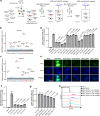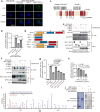EXTL3 and NPC1 are mammalian host factors for Autographa californica multiple nucleopolyhedrovirus infection
- PMID: 39231976
- PMCID: PMC11374996
- DOI: 10.1038/s41467-024-52193-w
EXTL3 and NPC1 are mammalian host factors for Autographa californica multiple nucleopolyhedrovirus infection
Abstract
Baculovirus is an obligate parasitic virus of the phylum Arthropoda. Baculovirus including Autographa californica multiple nucleopolyhedrovirus (AcMNPV) has been widely used in the laboratory and industrial preparation of proteins or protein complexes. Due to its large packaging capacity and non-replicative and non-integrative natures in mammals, baculovirus has been proposed as a gene therapy vector for transgene delivery. However, the mechanism of baculovirus transduction in mammalian cells has not been fully illustrated. Here, we employed a cell surface protein-focused CRISPR screen to identify host dependency factors for baculovirus transduction in mammalian cells. The screening experiment uncovered a series of baculovirus host factors in human cells, including exostosin-like glycosyltransferase 3 (EXTL3) and NPC intracellular cholesterol transporter 1 (NPC1). Further investigation illustrated that EXTL3 affected baculovirus attachment and entry by participating in heparan sulfate biosynthesis. In addition, NPC1 promoted baculovirus transduction by mediating membrane fusion and endosomal escape. Moreover, in vivo, baculovirus transduction in Npc1-/+ mice showed that disruption of Npc1 gene significantly reduced baculovirus transduction in mouse liver. In summary, our study revealed the functions of EXTL3 and NPC1 in baculovirus attachment, entry, and endosomal escape in mammalian cells, which is useful for understanding baculovirus transduction in human cells.
© 2024. The Author(s).
Conflict of interest statement
J. Liu is the founder and shareholder of Shanghai AsiFlyer Biotechnology. The remaining authors declare no competing interests.
Figures





Similar articles
-
Experimental and evolutionary evidence for horizontal transfer of an envelope fusion protein gene between thogotoviruses and baculoviruses.J Virol. 2025 Jul 22;99(7):e0214824. doi: 10.1128/jvi.02148-24. Epub 2025 Jun 25. J Virol. 2025. PMID: 40558095 Free PMC article.
-
Construction of a shortened autographa californica multiple nucleopolyhedrovirus genome as protein expression vector.Arch Virol. 2025 Jun 12;170(7):155. doi: 10.1007/s00705-025-06349-8. Arch Virol. 2025. PMID: 40504314
-
Adapting Next-Generation Sequencing to in Process CRISPR-Cas9 Genome Editing of Recombinant AcMNPV Vectors: From Shotgun to Tiled-Amplicon Sequencing.Viruses. 2025 Mar 18;17(3):437. doi: 10.3390/v17030437. Viruses. 2025. PMID: 40143364 Free PMC article.
-
Signs and symptoms to determine if a patient presenting in primary care or hospital outpatient settings has COVID-19.Cochrane Database Syst Rev. 2022 May 20;5(5):CD013665. doi: 10.1002/14651858.CD013665.pub3. Cochrane Database Syst Rev. 2022. PMID: 35593186 Free PMC article.
-
Management of urinary stones by experts in stone disease (ESD 2025).Arch Ital Urol Androl. 2025 Jun 30;97(2):14085. doi: 10.4081/aiua.2025.14085. Epub 2025 Jun 30. Arch Ital Urol Androl. 2025. PMID: 40583613 Review.
References
Publication types
MeSH terms
Substances
Supplementary concepts
Associated data
LinkOut - more resources
Full Text Sources
Molecular Biology Databases

